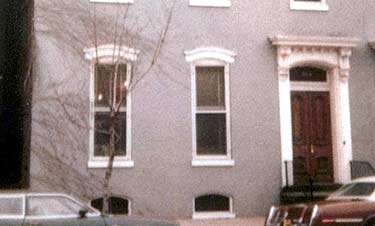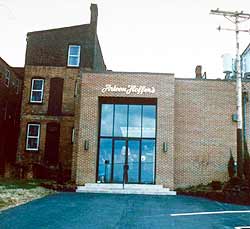



no.4
 If it's a historically distinctive side or rear elevation, DON'T
damage, destroy, or hide it!
If it's a historically distinctive side or rear elevation, DON'T
damage, destroy, or hide it!
::issueFOCUS:: Altering a distinctive rear elevation
::go to REHAB YES'S::
The
historic character...
This late 19th century, 3-story, brick rowhouse located in a small-town
historic district, is typical of other Victorian buildings with its Italianate
window and door trim and bracketed cornice (see top). Also characteristic
of many buildings in the district, it has a two-story kitchen wing at
the rear with a second-story porch featuring a decorative balustrade (see
right, below).
...and how it was lost in the rehabilitation.
Rehabilitation of the building essentially involved work to convert the
residence into a dress shop. The owner felt that the existing interior
space was inadequate for the retail operation, and, as a result demolished
the historic rear wing in order to build a much larger addition. Beause
of the loss of the distinctive rear porch coupled with construction of
a massive new addition that has a non-residential scale and appearance,
the work did not meet Standards 6 and 9. Finally, the
addition, below, radically changes the exterior form of the rowhouse.
|
No rear wing, but a new addition and parking. |
What should you know?
Attaching a new exterior addition usually involves some degree of loss
to an external wall or walls. For this reason, it is generally recommended
that an addition be constructed on a secondary side or rear elevation
where significant materials and features are less apt to be present. However,
where side or rear elevations are architecturally significant or where
they display either a distinctive individual plan or a plan characteristic
of buildings in the neighborhood, they need to be retained and preserved--not
damaged, destroyed, or hidden.
[TOP] 19th c. rowhouse, [BOTTOM] distinctive rear wing and porch. NPS Photos.

Standard 6: Deteriorated historic features shall be repaired rather than replaced. Where the severity of deterioration requires replacement of a distinctive feature, the new feature shall match the old in design, color, texture, and other visual qualities and, where possible, materials. Replacement of missing historic features shall be substantiated by documentary, physical, or pictorial evidence.
Standard 9: New additions, exterior alterations, or related new construction shall not destroy historic materials that characterize the property. The new work shall be differentiated from the old and shall be compatible with the massing, size, scale, and architectural features to protect the historic integrity of the property and its environment.

